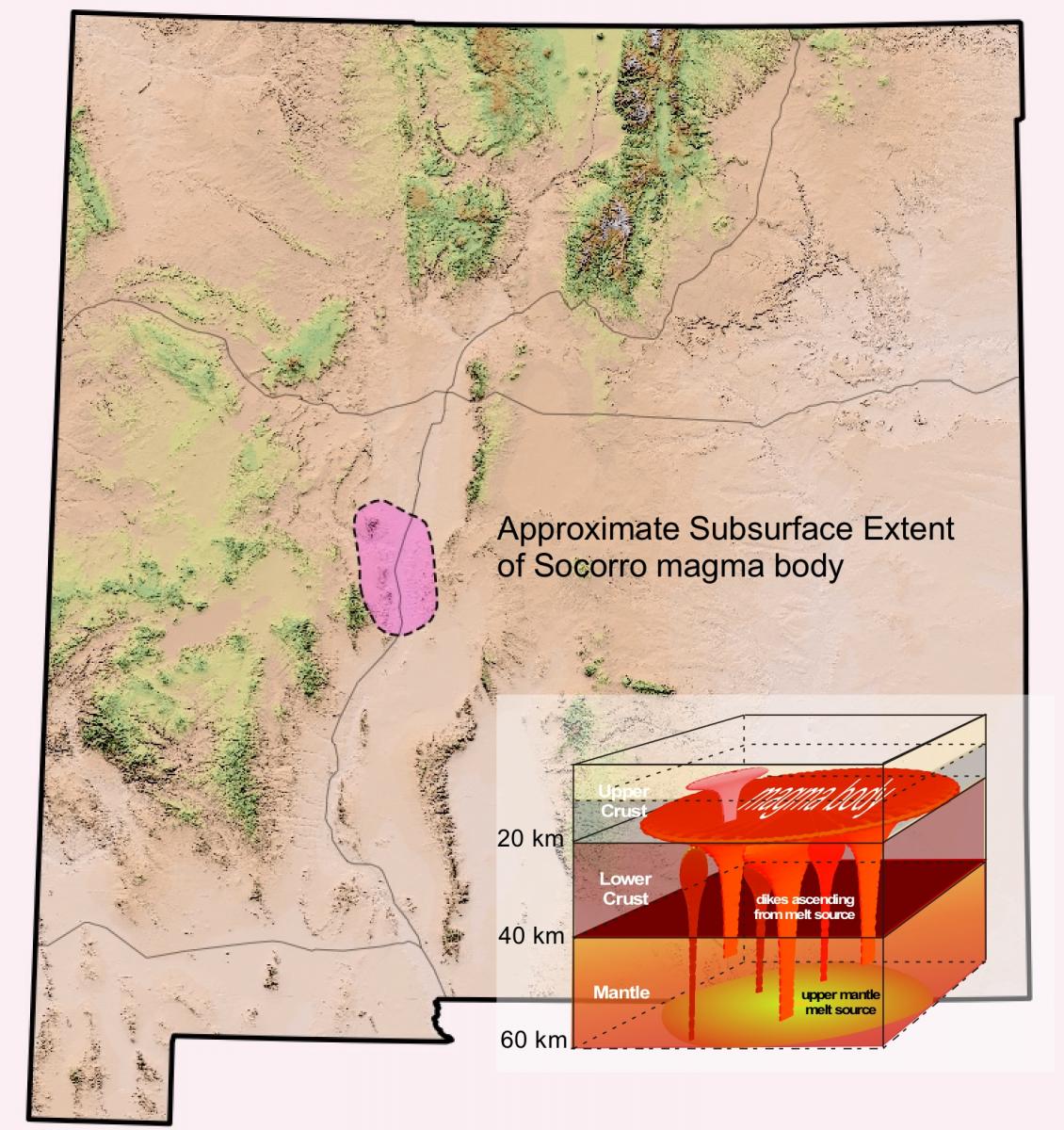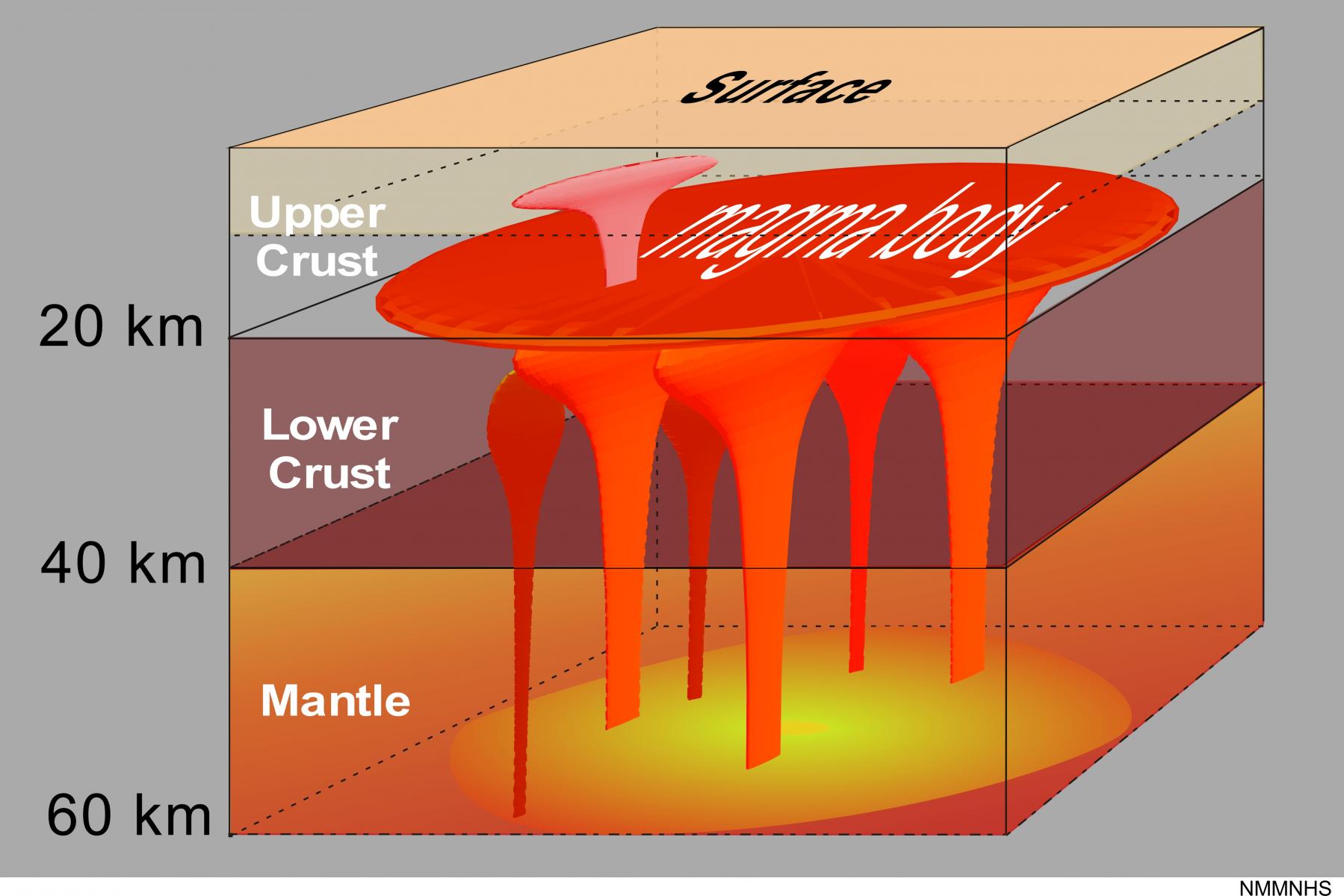
A proposed outline of the extent of the magma body relative to the State of New Mexico. This area also roughly outlines the extent of most of the shallow earthquake activity within New Mexico. In the lower right is a depiction oif one possible arrangment of the magam body. Conceptually, dikes periodically ascending from the mantle source stall at the mid-crustal boundary. Flexure of the overlying brittle crust gives rise to the abundant seismicity. .
The SMB lies at the southern end of the Albuquerque basin part of the Rio Grande rift (see image above). It is strictly defined as a mid-crustal anomaly identified by geophysical observations. These include the presence of unusual crustal properties, defined by analysis of the way seismic energy is reflected from the surface of the proposed magma body and transmitted through the crust from distant (teleseismic) earthquakes, and by the concentrated distribution of earthquakes. These observations define the presence of a crustal anomaly, but it is the close spatial correlation with the Socorro seismic anomaly (SSA) (Sanford et al., 1977), one of the most seismically active parts of the rift, that implies volume moments associated with active magma movement.
The SSA is a roughly 5000 km2 area of intense micoearthquake activity that coincides with the greater than 3400 km2 area (Balch, 1992; Balch et al., 1997) of the SMB defined from reflection data. Most of the microearthquakes in the SSA are located between a depth of 4 to 14 km (Jiracek et al., 1987). This is within the brittle zone lying above the approximate 20 km depth of the SMB mid-crustal anomaly. That the seismicity is anomalous is apparent when one considers that 45 percent of the total seismicity above magnitude 2.5 in New Mexico occurs within this area, yet it occupies only 2 percent of the area of the state (Balch, 1992). Hypotheses for the origin of the microearthquake activity include fractures caused by bending stresses in the brittle upper crust as the magma body inflates and fractures are induced during small vertical diking events. The inset in the lower right corner of the state map above and the drawing below is a simplified depiction of a possible configuration of the SMB and its feeder dikes. The salient characteristic is the great width relative to the thickness. Geophysical work to date suggests that the SMB is on the order of 0.1 to 0.5 km thick and contains a volume of 102 to 103 km3 (Ake and Sanford, 1987).

Drawing depicting the geometry of the proposed Socorro magma body. The main body occurs as a sheet roughly 100 m thick spread out at the interface between the upper and lower crust.
The volume of actual melt is not well constrained. Current methods do not resolve whether the region is comprised of a series of sheets separated by layers of solid or whether the entire layer consists of some large fraction of melt. It is likely that the layer is supplied by frequent arrivals of melt via dikes from the mantle source region. Occasionally, some dikes may move upward above the magma body to shallower (a few km) depths, based on the apparent presence of shallow bodies in the vicinity of Socorro (Sanford, 1979; Roach, 1982).
Some background references
Ake, J.P., and Sanford, A.R. , 1987, Internal Structure of the Socorro Magma Body Deduced from Microearthquake P-phase Reflections. Geophysics Open-file Report 55, Geophysical Research Center, New Mexico Institute of Mining and Technology.
Aldrich, M. J., Chapin, C. E., and Laughlin, A. W., 1986, Stress history and tectonic development of the Rio Grande rift, New Mexico: Journal of Geophysical Research, v. 91, p. 6199-6211.Balch, R. S., 1992, New constraints on the Socorro Magma Body based on improved hypocenter estimates: Geophysics Open-file Report 63, New Mexico Tech, Socorro, 120 pp.
Arnet, F., Kahle, H-G. , Klingelé, E., Smith, R. B., Meertens, C. M., and Dzurisin, D., 1997, Temporal gravity and height changes of the Yellowstone caldera, 1977-1994. Geophysical Research Letters, v. 24, p. 2741-2744.
Balch, R. S., 1992, New constraints on the Socorro Magma Body based on improved hypocenter estimates; Geophysics Open-file Report_63, Geophysical Research Center, New Mexico Institute of Mining and Technology, 120 pp.
Balch, R. S.,Hartse, H. E., Sanford, A. R., and Lin, K., 1997, A new map of the geographic extent of the Socorro magma body, Bulletin of the Seismological Society of America, v. 87, p.174-182.
Baldridge, W. S., 1979, Mafic and ultramafic inclusion suites from the Rio Grande rift (New Mexico) and their bearing on composition and thermal state of the lithosphere: Journal of Volcanoloy and Geothermal Research, v. 6, p. 319-351.
Bridwell, R. J., 1976, Lithospheric thinning and the late Cenozoic thermal and tectonic regiome of the northern Rio Grande rift; New Mexico Geological Society , 27th Field Conference Guidebook, p. 283-292.
Brocher, T. M., 1981, Geometry and physical properties of the Socorro, New Mexico, magma bodies: Journal of Geophysical Research, v. 86, p. 9420-9432.
Brown, L. D., Krumhansl, P. A., Chapin, C. E., Sanford, A. R., Cook, F. A., Kaufman, S., Oliver, J. E., and Schilt, F. S., 1979, COCORP seismic reflection studies of the Rio Grande rift; in Reicker, R. E., ed, Rio Grande rift tectonics and magmatism, American Geophysical Union, p. 169-184.
Crumpler, L. S., Head, J. W., and Aubele, J. C., 1995, Magma chambers associated with Calderas on Mars: significance of long-term magma replenishment rates. Lunar and Planeary Science XXVI, p. 305-306.
Decker, E. R., Bucher, G. J., Buelow, K. L., and Heasler, H. P., 1984, Preliminary interpretation of heat flow and radioactivity in the Rio Grande rift zone in central and northern Colorado: New Mexico Geological Society 35th Field Conference Guidebook, p. 45-50.
Dzurisin, D.,Wicks, C., and Thatcher, W., 1999, Renewed uplift at the Yellowstone Caldera measured by leveling surveys and satellite radar interferometry. Bulletin of Volcanology, v. 61, p. 349-355.
Fedotov, S. A., 1981, Magma rates in feeding conduits of different volcanic centers; Journal of Volcanology and Geothermal Research, v. 9, p. 379-394.
Fialko, Y., and Simons, M., 2001, Evidence for on-going in ation of the Socorro magma body, New Mexico, from Interferometric Synthetic Aperture Radar imaging. Geophysical Research Letters, v. 28, p. 3549-3552.
Foshag, W. F., and González, J., 1956, Birth and development of Parícutin volcano, Mexico; U. S. Geological Survey Professional Paper, 965-D. p. 355-489.
Glazner, A. F., and Ussler, W., 1989, Trapping of magfma at midcrustal density discontinuities: Geophysical Research Letters, v. 15, p. 673-675.
Gudmundsson, A., 1984, Formation of dykes , feeder-dykes, and the intrusion of dykes from magma chambers; Bulletin of Volcanology, v. 47, p. 537-550.
Gudmundsson, A., 1986, Mechanical aspects of postglacial volcanism and tectonics of the Reykjanes Peninsula, southwest Iceland; Journal of Geophysical Research, v. 91, p. 12,711-12,721.
Gudmundsson, A., 1988, Effect of tensile stress concentration around magma chambers on intrusion and extrusion frequencies; Journal of Volcanology and Geothermal Research, v. 35, p. 179-194.
Gudmundsson, A., Marinonib, L. B., and Martic, J., 1999, Injection and arrest of dykes: implications for volcanic hazards; Journal of Volcanology and Geothermal Research, v. 88, p. 1-13.
Hardee, H. C., 1982, Incipient magma chamber formation as a result of repetitive intrusions; Bulletin of Volcanology, v. 45, p. 41-48.
Hermance, J. F., and Pedersen, J., 1980, Deep structure of the Rio Grande ridt: a magnetotelluric interpretation: Journal of Geophysical Research, v. 85, p. 3899-3912.
Hermance, J. F., and Neumann, G. A., 1991, the Rio Grande rift: new electromagnetic constraints on the Socorro magma body: Physics of the Earth and Planetary Interiors, v. 66, p. 101-117.
Juracek, G. R., Ander, M. E., and Holocome, H. T., 1979, Magnetotelluric soundings of crustal conductive zones in major continental rifts; in Reicker, R. E., ed, Rio Grande rift tectonics and magmatism, American Geophysical Union, p. 209-222.
Juracek, G. R., Rodi, W. L., and Vanyan, L. L., 1987, Implications of magnetotelluric modeling for the deep crustal environment in the Rio Grande rift; Physics of the Earth and Planetary Interiors, v. 45, p. 179-192.
Kelley, V. C., 1979, Tectonics, middle Rio Grande rift, New Mexico; in Reicker, R. E., ed, Rio Grande rift tectonics and magmatism, American Geophysical Union, p. 57-70.
Larsen, S., R. Reilinger, and L. Brown, 1986, Evidence for ongoing crustal deformation related to magmatic activity near Socorro, New Mexico, Journal of Geophysical Research, 91, 6283-6292.
Lister, J. R., Campbell, I. H., and Kerr, R. C., 1991, The eruption of komatiites and picrites in preference to primitive basalts; Earth and Planetary Science Letters. v. 105, p. 343-352.
Morgan, P., and Golombek, M. P., 1984, Factors controlling the phases and styles of extension in the northern Rio Grande rift: New Mexico Geological Society 35th Field Conference Guidebook, p. 13-20.
Pollard, D.D., and Muller, O. H., 1976, The effects of gradients in regional stress and magma pressure on the form of sheet intrusions in cross section: Journal of Geophysical Research, v. 81, p. 975-984.
Olsen, K. H., Keller, G. R., and Stewart, J. N., 1979, Crustal structure along the Rio Grande rift from seismic refraction profiles; in Reicker, R. E., ed, Rio Grande rift tectonics and magmatism, American Geophysical Union, p. 127-143.
Ouchi, S., 1983, Effects of uplift on the Rio Grande over the Socorro magma body, New Mexico; New Mexico Geological Society 34th Field Conference Guidebook, p. 54-56.
Pierce, K. L., Cannon, K. P., and Meyer, G., 1996, "Heavy breathing" of the Yellowstone Caldera based on Yellowstone Lake and river changes in post-glacial time. Geological Society of America Abstarcts with Programs, v. 28, p. 514-515.
Ranalli, G., and Murphy, D. C., 1987, Rheological stratification of the lithosphere: Tectonophysics, v. 132, p. 281-295.
Reiches, Z., and Fink, J., 1988, The mechanism of intrusion of the Inyo dike, Long Valley caldera, California; Journal of Geophysical Research, v. 93, p. 4321-4321.
Reilinger, R., and Oliver, J., 1976, Modern uplift associated with the proposed magma body in the vicinity of Socorro, New Mexico: Geology, v. 4, p. 573-586.
Reilinger, R., Oliver, J., and Brown, L., 1979, New measurements of crustal doming over the Socorro magma body, New Mexico. Geology, v. 8, p., 291-295.
Rinehart, E. J., Sanford, A. R., and Ward, R. M., 1979, Geographic extent and shape of an extensive magma body at mid-crustal depths in the Rio Grande rift near Socorro, New Mexico: in Rio Grande Rift; in R. E. Riecker, ed, Tectonics and Magmatism: American Geophysical Union, Washington, D.C., p. 237-251.
Roach, J. M., 1982, The mapping of shallow magma bodies near Socorro, New Mexico by the use of seismic attenuation. Geophysics Open-file Report 42, Geophysical Research Center, New Mexico Institute of Mining and Technology.
Sanford, A. R., Mott, R. P., Shuleski, P. J., Rinehart, E. J., Caravella, F. J., Ward, R. M., and Wallace, T. C., 1977, Geophysical evidence for a magma body in the vicinity of Socorro, New Mexico; in Heacock, J. G., ed, The Earth's Crust: Its Nature and Physical Properties: Geophysical Monograph Series, 20, American Geophysical Union, Washington, D.C., p. 385-404.
Sanford, A. R., 1979, Characteristics of the Rio Grande rift in the vicinity of Socorro, New Mexico, from geophysical studies; Guidebook to the Rio Grande Rift in New Mexico and Colorado, Circular 116, p. 116-119.
Sanford, A. R., Mott, R. P., Shuleski, P. J., Rhinehart, E. J., Caravella, F. J., Ward, R. M., and Wallace, T. C., 1977, Geophysical evidence for the existence of a magma body in the vicinity of Socorro, New Mexico; in Heacock, J. G., ed, The Earth's Crust: Its Nature and Physical properties. Geophysical Monograph Series, 20, p. 385-404.
Savage, J. C., Lisowski, M., Prescott, W. H., and Sanford, A. R., 1980, Geodetic measurement of horizontal deformation across the Rio Grande rift near Socorro, New Mexico: Journal of Geophysical Research, v. 85, p. 7215-7220.
Schlue, J., Aster, R., Meyer, R., 1996, A lower-crustal extension to a mid-crustal magma body in the Rio Grande rift, New Mexico: Journal of Geophysical Research, v. 101, p. 25,283-25,291.
View Socorro Active Magma Body in a larger map



